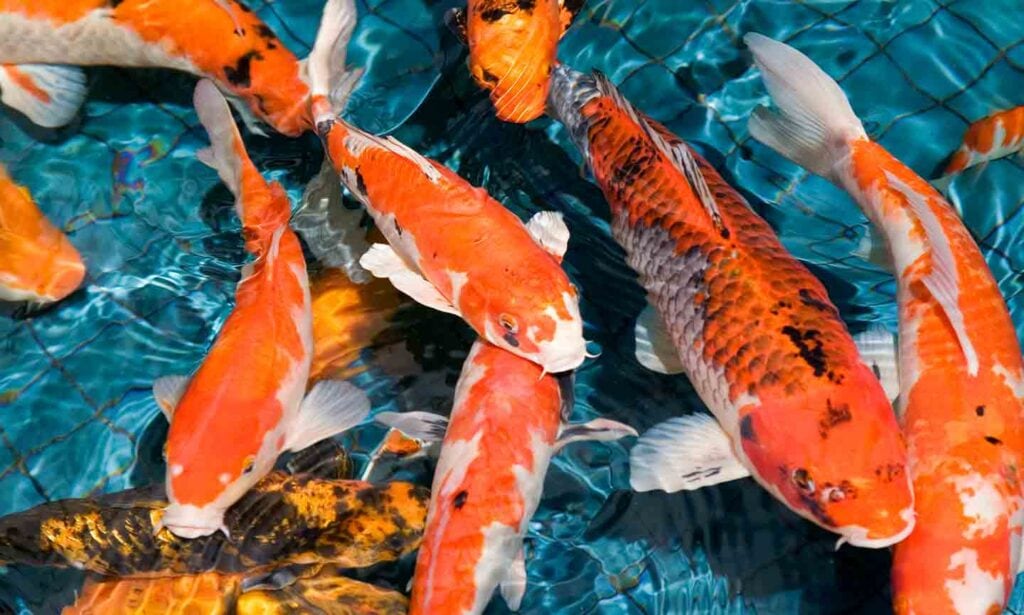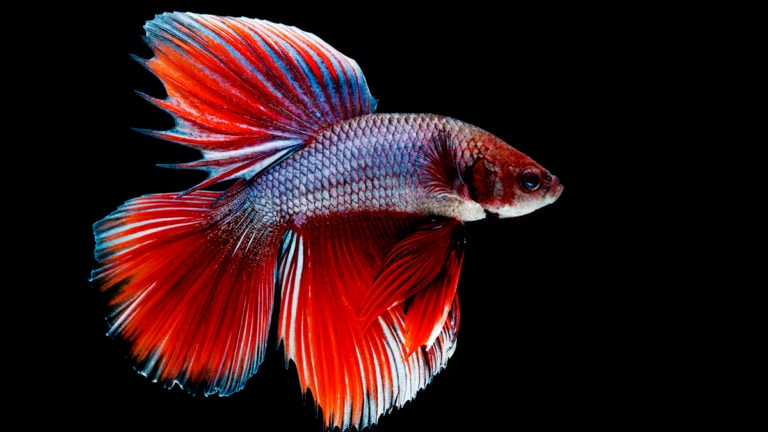In This Guide:
Buying or Adopting Koi Fish
The price range for koi fish is, well, pretty broad: It starts at around $10 for a juvenile fish and scales to over $20,000 for an adult, show-quality, Japanese koi fish.
As an alternative to purchasing koi from a fish farm or pet store, koi enthusiasts have the option to adopt from a koi rescue. Joseph Jaramillo, rescue coordinator for Southern California Koi Rescue in Los Angeles, says, “Koi adoption provides hobbyists a unique opportunity to save money while also helping to save a life.”
Rehoming fees can be pennies on the dollar compared to the typical purchase price of koi. For example, the rehoming fee for many jumbo koi fish from Southern California Koi Rescue is around $50. For comparison, the average starting price for large koi from a California-based supplier is $225.
What Are the Most Expensive Koi?
There are over 100 types of koi, each distinguished by color, pattern, and body shape. Three of the most popular Japanese koi varieties—collectively known as Gosanke—include Kohaku, Sanke, and Showa. Other popular varieties include Asagi, Ginrin, Doitsu, Utsuri, Ogon, and Butterfly Koi.
According to Jessie Sanders, DVM, DABVP (Fish Practice), the owner and chief veterinarian of Aquatic Veterinary Services in Santa Cruz, California, “Koi tend to be more or less expensive depending on their lineage and genetics, mostly body composition and color patterns.”
At the low end of the koi price range you’ll find pond-quality koi, which typically sell for $10-$100 per fish. Show-quality koi are the high-quality koi fish, which easily fetch prices over $10,000.
Dr. Sanders says, “Japanese show koi tend to be the most expensive with very particular color patterns and large body size. Domestic koi are typically smaller with a larger variety of colors.”
First-Day Koi Fish Supplies
Let’s review some of the supplies you’ll need to keep koi.
A Pond
Before purchasing or adopting koi, you’ll need a pond. If you don’t have one already, think carefully about the size and location of your pond. Costs vary greatly but, generally speaking, the larger the pond, the more expensive it will be to build.
Decor Elements
Enhance the appearance of your pond by using natural decor elements like rocks and terrestrial plants. Lighting and water features like waterfalls can help your pond stand out, while aquatic plants like water lilies and water lotus can help give it a natural look.
Filtration System
Proper filtration is essential to keep your pond water clean and clear. Choose a pond filter appropriate for your pond size and setup.
Pond Skimmer
While a pond filter removes small particles and loose debris from the water column, a pond skimmer traps large debris that accumulates on the water’s surface.
Optional Equipment
A pond pump keeps water circulating properly, while an aerator increases dissolved oxygen levels for your koi. A UV clarifier can help mitigate problems with bacteria and algae. In cooler climates, you may also need a pond heater or de-icer.
Water Treatments
To make your pond safe for koi, you may need certain water treatments like chlorine and heavy metal neutralizer. It doesn’t hurt to keep other basics like pond fish medications and algae control solutions on hand.
Fish Food
While your koi may feed on bugs and plants in the pond, a balanced commercial koi food is essential for optimal health.
Initial Setup Costs for Koi Fish
Pond
$800-$15,000
Decor Elements
$100-$1,500
Filtration System
$30-$500
Pond Skimmer
$50-$300
Optional Equipment
$0-$300
Water Treatments
$0-$250
Fish Food
$10-$150
Total
$990-$18,000
Let’s review the costs to keep up a koi pond on a monthly and yearly basis.
Fish Food
Feeding your koi is going to be your primary ongoing expense. Expect to spend between $50 and $200 per fish on food for your koi each month.
Utilities
Utility expenses include the cost to run electrical pond equipment and water fees to refill the pond after water changes. On average, it costs between $10 and $200 per month to run a small to medium koi pond.
Pond and Equipment Maintenance
Routine maintenance costs may include replacement filter pads, water treatments, and equipment replacement parts. If you do it yourself, these costs may be as low as $10 per month. The alternative is to hire a professional service to do pond maintenance, which can range from $75 to $400 or more per month.
Unexpected Costs
Unexpected costs may range from minor pond repairs to expensive veterinary treatments. “The cost could vary widely depending on the type of issue present,” says Dr. Sanders, “such as less than $100 for a few bags of pond salt to treat an ectoparasite outbreak to up to a few thousand dollars for surgical treatment.” On-site veterinary exam fees can vary greatly as well.
Average Annual Costs of Keeping Koi Fish
Fish Food
$600-$2,400
Utilities
$120-$2,400
Pond & Equipment Maintenance
$120-$4,800
Vet Visits
$50-$300
Veterinary Treatments
$0-$3,000
Total
$890-$12,900
Why Are Koi Fish So Expensive?
Koi are members of the family Cyprinidae or carp family—so are goldfish. While the best koi varieties command prices in the hundreds or thousands, pet goldfish are often sold for as little as $1. The reasons behind the higher price tag are both practical and cultural.
For their vibrant colors, significant size, and hardy nature, koi offer a desirable alternative to other ornamental fish for backyard ponds. Koi come in a wide range of colors and patterns, enabling hobbyists to stock their ponds according to individual aesthetic preferences. The rarer or more specific the pattern, the higher the price tag. Koi also meet the demand for hardy pond stock that can survive winters in the USA.
Aside from their objective benefits as pond fish, koi have a great deal of cultural significance, which also influences their price.
For thousands of years in Japan and China, the koi fish has been a symbol of good fortune as well as strength, ambition, and perseverance. Many who kept koi regarded them as status symbols or as spiritual tokens, putting great effort into their care in the hopes that doing so would bring good fortune to their family.
It wasn’t until the early 1900s when the koi hobby gained widespread popularity. When the original Nishikigoi koi were exhibited in Tokyo, Japan, it sparked a fervor among koi breeders and enthusiasts. Today, koi are valued as much for their beauty and specific genetic lineages as for their more general cultural and historical significance.
FAQs About Koi Fish Costs
Q:How long do pet koi fish live?
A:According to Dr. Sanders, “If kept properly, koi can live 40-60 years.” A balanced diet and an appropriate habitat are key to maximizing the lifespans of ornamental pond fish like koi.
Q:How much is the most expensive koi goldfish?
A:The highest recorded cost for the sale of a koi fish was $1.8 million in 2018. High-end koi often sell for $2,500 to $5,000, while show-quality fish fetch prices in the tens of thousands.
Q:Are koi fish expensive to maintain?
A:Initial costs to set up and stock a koi pond are often higher than the average indoor aquarium. Over time, however, maintenance costs are similar but scale up according to the size of the pond and the number of koi.
If you’re ready to stock your pond but are concerned by how much koi fish cost, consider working with a local koi rescue instead of buying from a breeder or pet store. It may take a little longer to find exactly what you want but, if you’re not picky, the savings could be substantial. Learn more about buying koi fish here.
Expert input was provided by Jessie Sanders, DVM, DABVP (Fish Practice), owner and chief veterinarian of Aquatic Veterinary Services in Santa Cruz, California; and Joseph Jaramillo, rescue coordinator for Southern California Koi Rescue in Los Angeles, California.
Share:












